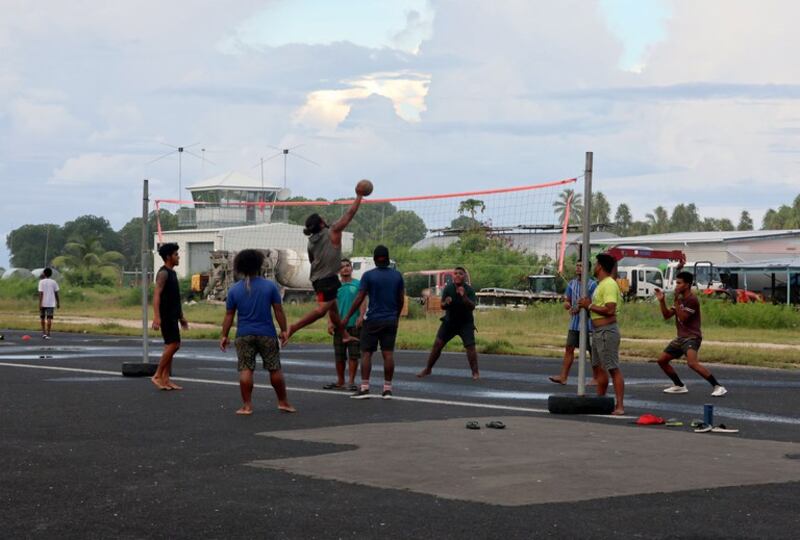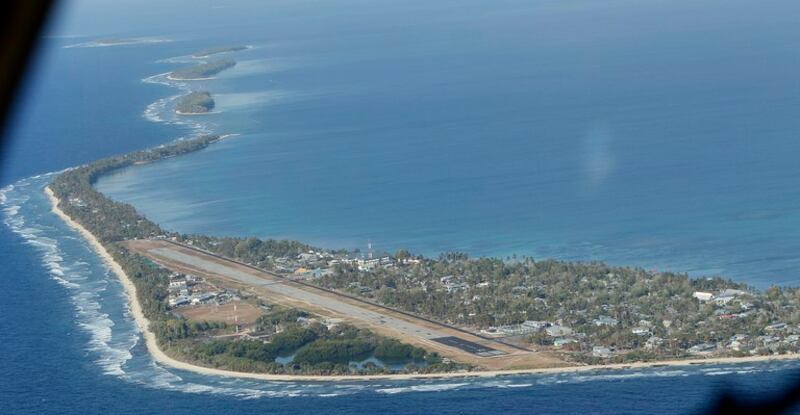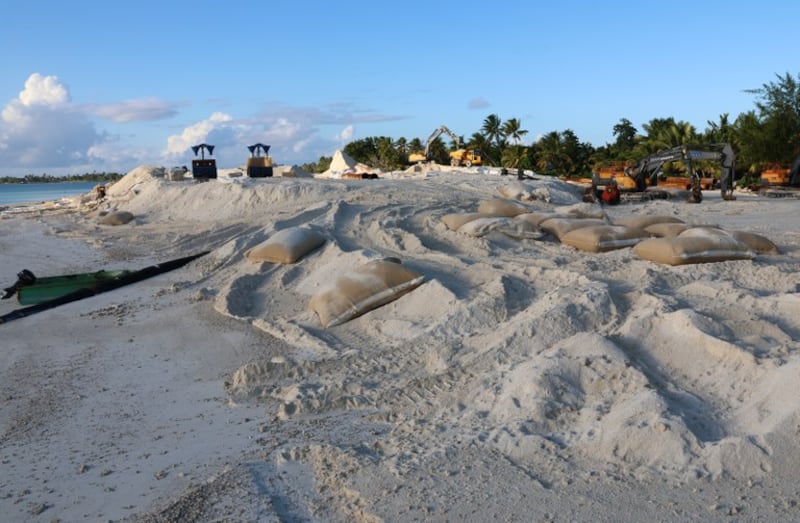Before dawn a small crowd forms at a huddle of blue and green buildings beside the airport runway that dominates Tuvalu’s most populated coral island.
Sometimes people come as early as 4 a.m., hoping to be first in line for the precious supply of fresh fruit and vegetables.
As people arrive they cross the runway by car, motorbike or on foot. By opening time, an orderly queue has materialized. People sit on chairs or stand while they wait their turn.
Numbers are called and small groups eagerly converge on benches stacked with brightly colored crates. People haul out papaya, leafy greens and ample-sized cucumbers.
“It’s very hard to get fresh vegetables and fruit. This is the only place where we can get the fresh ones,” said grandmother Seleta Kapua Taupo as she waited her turn. “Most of the cabbages when they come [from overseas], most of the carrots, they are already in a stage of getting rotten and we don’t want to have that.”
People are grateful for the vegetables, grown in rows and rows of boxes raised off the porous atoll ground, but some also say it’s never enough. Because Tuvalu is so small – its islands spread over a vast expanse of the Pacific Ocean comprise only 26 square kilometers (10 square miles) – there’s no space for the garden to expand despite its important role in countering an unbalanced diet.
Taiwan’s aid agency, which established the garden as a demonstration project last decade, estimates it now provides most of the fruit and vegetables consumed on Funafuti – Tuvalu’s principle coral atoll made up of islets of barely arable land and reefs encircling the sapphire waters of a lagoon.
The constraints on the garden show the tradeoffs that low-lying micronations in the Pacific such as Tuvalu grapple with and which will only get more intractable as scarce land is lost to sea-level rise. Without building up and extending land that averages an arm’s length above the high-tide, half of Funafuti will be inundated by tidal waters by 2050 and 95% by the end of this century, based on one-meter of sea-level rise projected by the Intergovernmental Panel on Climate Change.
Aside from locally caught fish and shellfish, much of Tuvalu’s food is imported, expensive and low in nutrition.
Restaurant staples here are large plates overflowing with white rice and fried meat. Cans of Fanta and Coke cost less than bottled water.
“Before we had this market, most of us didn’t know how to use these vegetables,” Taupo said.
“Before, my grandchildren didn’t like vegetables in their food. But I cut them very small and put them in the soup, so they have no choice,” she said, chuckling. “So now they are used to it and they start to love even the salad. Now they love the salad.”
Funafuti at its widest is about 400 meters (1,312 feet), a parcel of land that packs together the airport runway, government buildings and infrastructure and homes. Between the two to three international flights a week, the runway is a lively town square where people flock to socialize or play football and volleyball in the evenings.
At one of the atoll’s narrowest slivers, mere meters, the view takes in ocean waves crashing on one side of the road while lagoon waters lap placidly on the other.
“You don’t want to think about it, that it’s going to disappear,” said Suzanne Kofe, who has repurposed an old shipping container into Sue’s Cafe, serving burgers to locals and the weekly influx of U.N. and other advisers that make up most of Tuvalu’s foreign visitors.
“That’s what scientists say, that it will disappear,” she said. “But I believe it’s not in my lifetime.”

Tuvalu has become emblematic of the plight faced by low-lying islands from projected sea level rise over the coming century.
Its coral atolls, a two-and-a-half hour flight north of Fiji, are home to only 12,000 people, and most people couldn’t locate them on a world map. Yet with clever public relations, fronted by its Foreign Minister Simon Kofe, Tuvalu has called attention to its situation and helped galvanize calls for faster action to reduce reliance on fossil fuels.
In October 2021, a video of Kofe standing knee-deep in the ocean while delivering Tuvalu’s message to the annual U.N. climate change conference went viral online and was reported by news organizations worldwide.
The following year, Kofe was superimposed into a three-dimensional digital replica of Te Afualiku, an uninhabited filament of palms and pulverized coral that he predicted would be one of the first Tuvaluan islets to disappear.
He gravely intoned that Tuvalu would upload a digital copy of itself to the metaverse, a purported virtual world accessed through bulky VR goggles, so there would be a record of Tuvaluan culture if its islands become submerged by rising seas.
Months after the idea of a virtual-reality Tuvalu briefly held the world’s attention, it remains more a macabre stunt than reality.
“We’ve been advocating for decades now on the international stage and this is probably the most effective we’ve been,” said Kofe, “in getting the world’s attention on issues of climate change.”

The tech industry’s brief but expensive infatuation with the still largely hypothetical metaverse – hyped up in 2021 by Facebook founder Mark Zuckerberg as the future of the internet – is now ridiculed by technology commentators.
Facebook-owner Meta, which invested billions of dollars in its own video-game-like version of the metaverse only for it to flop, has laid off thousands of employees. It says it is now investing more in artificial intelligence.
“The metaverse as Zuckerberg has defined it has been abandoned not just by originally supportive companies, like Disney, Microsoft and Tencent, but even by Meta itself,” said Jordan Guiao, a research fellow at the Australia Institute’s Centre for Responsible Technology.
“There may be more practical and specific applications being trialed,” he said, “but the grandiose and much overhyped visions that we saw over the last 18 months have not come to fruition.”
Societies need to develop policy and initiatives grounded in reality, “as opposed to imagined reality, to solve our problems,” Guiao said.
Business services company Accenture, which rendered Te Afualiku digitally after proposing the idea to Tuvalu, said it’s currently not viewable in the metaverse.
Even if it were, it would be near impossible to experience it in Tuvalu due to limited Internet bandwidth.

Despite the attention it has garnered, a virtual Tuvalu is only a small part of the strategy to ensure the country remains recognized as a sovereign state in the “worst-case scenario” of being swallowed by the Pacific Ocean, according to Kofe.
He insists that digital Tuvalu will become a reality and points to Singapore, which uses an immersive digital twin of the city-state for urban and environmental planning.
“We’re at the early stages of it but a time will come and people will be able to have the access to it,” Kofe said.
“The challenge that many of the tech companies have now is to find a user case for that sort of platform,” he said.
“There has been a lot of interest in what Tuvalu is doing because they [tech companies] see the value of it, there’s a sense of purpose in developing something that could actually help save and preserve a culture.”
Reclaiming an island
Just a two-minute stroll from Kofe’s modest office in the low-rise government building, backhoes and trucks maneuver around giant earth-filled sacks as azure waters wash against an expanding palisade of sand dredged from the lagoon.
An Australian marine engineering company, Hall Pacific, is creating more than seven hectares of new land along a 780-meter (2,560-feet) stretch of lagoon waterfront.
At roughly 4% of the existing area of Funafuti’s largest island, it’s a significant addition to the atoll that would also bolster the ability to withstand king tides and tropical cyclones.
The cost, including coastal protection works for two outer islands Nanumaga and Nanumea to stop them being swamped by storm waves, is about U.S. $30 million.
The project has been several years in the making and is only the first steps in a much larger vision.
“A solution for us,” Kofe said, “is to reclaim land, build sea walls and even raise our islands in some parts – that’s a solution that we see that’s viable for the people of Tuvalu and to save our people.”

Unveiled in November by Tuvalu’s government and the U.N. Development Programme, the decades-long plan to survive higher sea levels envisages more than doubling the size of Tuvalu’s most populated island and linking it to two smaller islets by reclaiming 3.6 square kilometers (1.4 square miles) from the lagoon.
“All involved hope that work will begin very soon and that it will become reality before sea-level rise critically endangers people and property,” said UNDP coastal adaptation expert Arthur Webb.
He said up to U.S. $7 million was needed now for design and engineering studies. He declined to say how much the proposed reclamation works could cost in total.
“There is no conventional adaptation fund or facility that Tuvalu can apply to for assistance on this scale, at this time,” Webb said. “Thus we must now think creatively about how we achieve what needs to be done.”
The plan proposes relocating residents and infrastructure to the reclaimed area and later possibly raising the level of the original island before revegetating it.
The airport would be moved to a finger of land at one end of the enlarged islet and also serve as a water catchment for the thirsty islands that depend on rainfall for their water.
Tuvalu’s government and its international advisers now need to secure the support of Tuvaluans and the considerable funding to make the plan a reality.
“Obviously we will continue to advocate on the international playing field for countries to take stronger climate action,” Kofe said. “But I think we also need to focus our energy on things that are within our control.”
BenarNews is an online news agency affiliated to Radio Free Asia.

